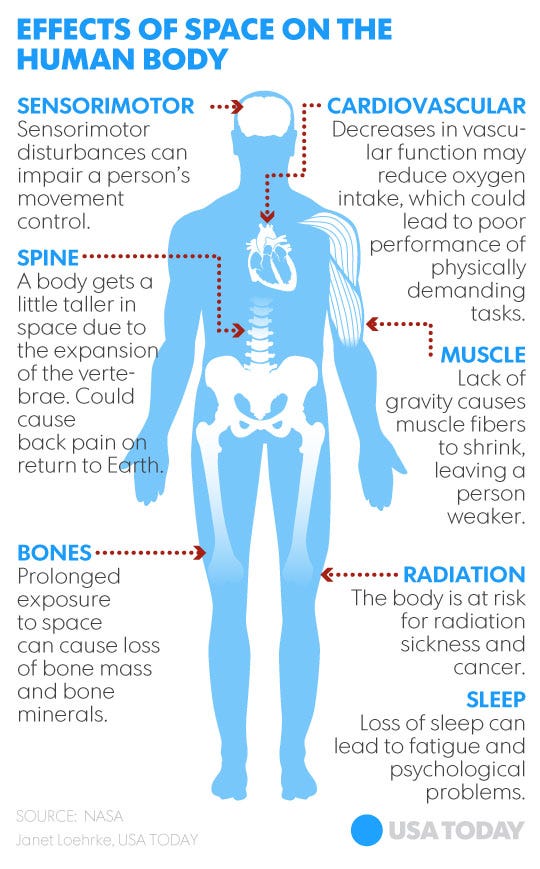After a year in space, Scott Kelly returns 2 inches taller

NASA astronaut Scott Kelly returned to the U.S. on Thursday after spending nearly a year in space.
Now that Kelly is home, his journey is just beginning. Scott Kelly's year in space was part of a NASA twin study involving his brother, Mark Kelly.
While Scott was in space, Mark remained earthbound, which will allow scientists to study the effects of space travel on the human body in preparation for a crewed mission to Mars.
Specifically, researchers are looking at the effects of space radiation, as well as the effect of visual impairment associated with long-duration space flight, according to Graham Scott, chief scientist at the National Space Biomedical Research Institute and deputy project scientist for the NASA and NSBRI Twin Study.
So, what can a year in space do to the human body?
Vision
One of the primary things researchers will be focusing on is the effect that being in space for almost a year had on Kelly's vision, according to Scott.
“We will be looking at the eyes to see how much visual acuity has been lost,” he said during a phone interview Thursday.
Scott said the majority of astronauts who return from time in space have mild vision loss, but researchers still aren’t completely sure why vision is affected while in space.
“The majority of astronauts have to change their eye glasses while in space,” he said. “They bring eye glasses with them and typically change a few months into the mission.”
Bones and muscles
For almost a year, Scott Kelly did not have to use his legs to walk, but instead floated to different areas of the space station. In the past, astronauts would leave space with brittle bones and weak muscles because of the lack of use while in space, according to Scott.
But today, researchers have helped mitigate the impact on bones and muscles by implementing extensive workout routines that astronauts carry out while in space. Scott said onboard the International Space Station astronauts tie themselves down to a treadmill, strap into a bike and use a resistance device to work out for 2 to 2.5 hours a day.
“The workouts have positively impacted the astronauts' bones and muscles, and they are coming back in really good shape,” he said. “But some are losing bone and muscle but not as much as we saw in the early days."
When the bones breakdown, they release calcium, which can also lead to kidney stone formation and bone fractures. Likewise, the lack of use causes muscles to become weak and shrink, which can leave astronauts less coordinated when they return to Earth, according to NASA.
Inspiring tweets from Scott Kelly's #YearInSpace
Long-term effects of radiation
Radiation is the biggest issue that astronauts will face as they eventually journey to Mars, Scott said.
On the International Space Station, astronauts get 20 times the amount of radiation people on Earth are exposed to, according to Scott.
“If you go on a journey to Mars and get into deep space, there is several hundred times, maybe 300 times the radiation,” he said.
He said researchers are extremely interested in the effect radiation has on the heart, blood vessels, bones, central nervous system and the brain. As well as the cancer risk.
He notes that Kelly’s medical study with NASA will continue long after this year, with yearly physical checkups.
The heart can shrink
While in space, the cardiovascular system does not have to work as hard as it does on Earth.
“Just like the bones and muscles, the heart is designed to work in one gravity here on Earth, so when you put the heart in space it operates differently and changes shape,” Scott said.
He notes that one of the transitionary effects of returning to Earth is that astronauts can feel faint. Scott said that's one of the reasons that when astronauts return to Earth, they are placed on custom beds to ensure they don't faint while they are up and walking around.
There is also worry that radiation can accelerate coronary heart disease.
Body
One obvious and temporary change for Kelly was that he came back 2 inches taller than his brother because a lack of gravity causes spinal disks to expand.
When astronauts return to Earth, they must re-adjust to gravity and can have issues with balance and simple tasks like standing up, walking or operating a vehicle.
Scott said astronauts go through a physical reconditioning program and are typically functioning normally within one-to-three weeks unless they've suffered significant bone or muscle loss, which could take months or years to recover from.
Follow @MaryBowerman on Twitter.
